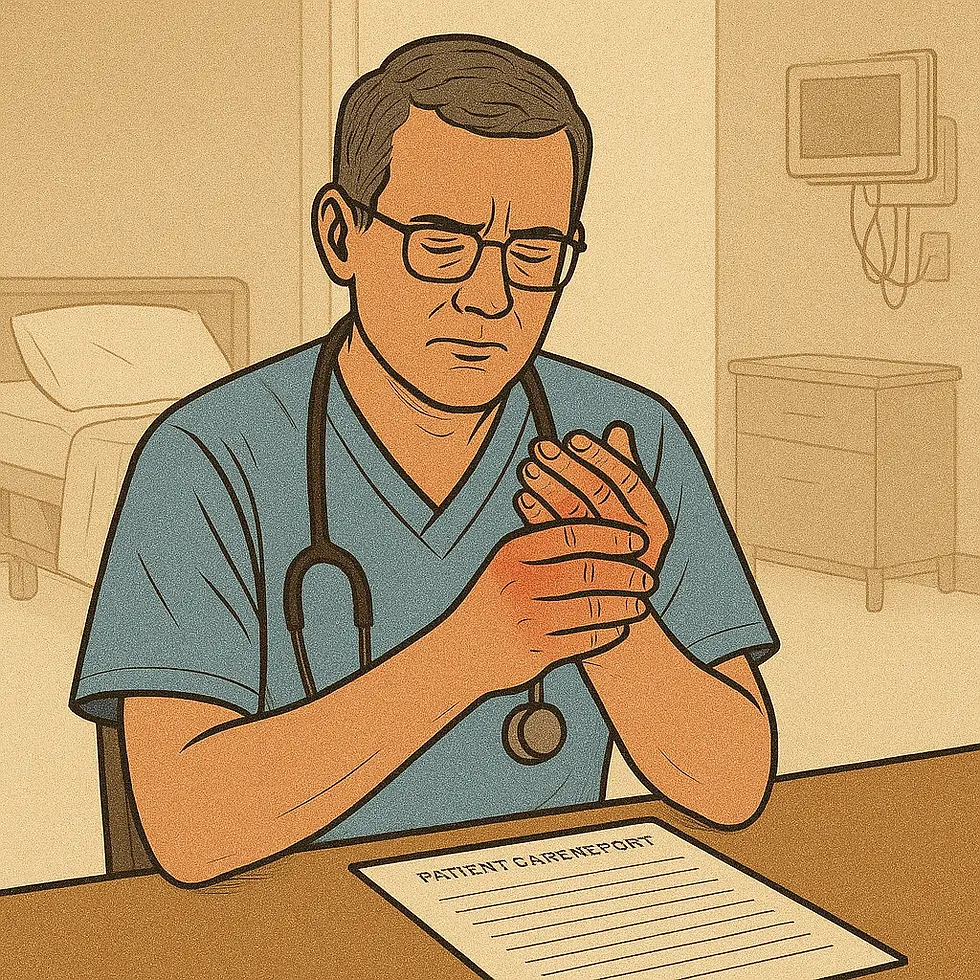Types of Arthritis
- Grace. T

- Sep 9
- 4 min read
Updated: Nov 18

Arthritis Awareness Month: Understanding the Different Types of Arthritis
Arthritis is not a single condition but a group of more than 100 disorders that cause joint inflammation, pain, and stiffness. For nursing students, understanding the types of arthritis is essential when supporting patients in both acute and long-term care settings. Early recognition of symptoms allows for better patient education, improved care planning, and effective collaboration with interdisciplinary teams.
Common Types of Arthritis
1. Osteoarthritis (OA)
Definition: The most common form of arthritis, caused by the gradual breakdown of cartilage in the joints.
Symptoms: Joint stiffness (especially in the morning), pain that worsens with activity, swelling, and decreased range of motion.
Why This Is Important: Cartilage degeneration leads to bone-on-bone contact, causing chronic pain and reduced mobility. For nurses, recognizing OA early allows interventions like weight management, physiotherapy referrals, and patient education on activity modification before joint replacement becomes necessary.
Care Instructions: Knee Arthritis: Care Instructions
2. Rheumatoid Arthritis (RA)
Definition: A chronic autoimmune disease where the immune system mistakenly attacks joint tissues.
Symptoms: Symmetrical joint pain, morning stiffness lasting longer than 30 minutes, fatigue, and joint deformities over time.
Why This Is Important: RA is systemic—it not only affects joints but can involve the lungs, heart, and eyes. Uncontrolled inflammation ca n cause permanent joint destruction within two years of onset. Nurses play a critical role in monitoring disease-modifying antirheumatic drug (DMARD) effectiveness, identifying adverse effects, and supporting adherence to therapy.
Care Instructions: Rheumatoid Arthritis (RA): Care Instructions
3. Juvenile Idiopathic Arthritis (JIA)
Definition: The most common type of arthritis in children, with unknown cause.
Symptoms: Persistent joint swelling, pain, and limited movement in children under 16.
Why This Is Important: JIA can interfere with bone growth and development if left untreated, leading to long-term disability. Nurses must advocate for early intervention, encourage adherence to therapy, and support families through the psychosocial impacts of chronic illness in childhood.
Care Instructions: Juvenile Idiopathic Arthritis: Care Instructions
4. Gout
Definition: A form of inflammatory arthritis caused by the buildup of uric acid crystals in joints.
Symptoms: Sudden, severe pain and swelling, most commonly in the big toe.
Why This Is Important: If unmanaged, gout can progress to chronic arthritis with tophi (uric acid crystal deposits) and kidney damage. Nurses are key in educating patients about low-purine diets, hydration, and consistent use of uric acid–lowering medications, which can prevent long-term complications.
Care Instructions: Gout: Care Instructions
Definition: An inflammatory arthritis associated with psoriasis, an autoimmune skin condition.
Symptoms: Joint pain, stiffness, swelling, and nail changes (pitting, separation).
Why This Is Important: Psoriatic arthritis can cause severe joint damage if untreated and is often underdiagnosed because patients present first with skin lesions. Nurses who recognize the joint-skin connection can facilitate early rheumatology referrals and improve long-term outcomes.
Care Instructions: Psoriatic Arthritis - Treatment & Medication | Arthritis Society Canada

Nursing Considerations
Pain Management: Implement both pharmacologic (NSAIDs, corticosteroids) and non-pharmacologic (exercise, heat/cold therapy) strategies.
Mobility Support: Encourage safe physical activity and joint protection techniques.
Psychosocial Care: Assess for depression and anxiety, which are common in patients with chronic arthritis.
Patient Education: Promote adherence to treatment plans, lifestyle modifications, and use of assistive devices when needed.
💡 Ready to Get Certified?
Be prepared. Be confident. Learn First Aid Today & Save a Life Tomorrow with Saving Grace Medical Academy Ltd. Now enrolling: Basic Life Support (BLS) & Standard First Aid CPR-C & AED courses designed for healthcare professionals.
📍 Training for First-Year Nursing Students
Join Saving Grace Medical Academy Ltd. for fully certified, CSA-compliant Standard First Aid CPR-C & AED courses—designed for Alberta’s future healthcare professionals.
Just Remember:
Protect Yourself. Call 911.Don’t Waste Time.
RESOURCES:

Author - Saving Grace Medical Academy Ltd
Grace. T
Medical Content Writer







